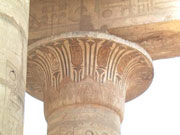TOUR NEWS - SUDAN JANUARY 2011
The much anticipated inaugural B.C. Archaeology Tour of Ancient Sudan took place from 9th - 25th January and was a great success. The tour had an emphasis on the ruins between the Sudanese capital Khartoum and the Egyptian frontier to the north. The group included: Robert Snow, John Burke, Colin Sheppard, Alex Kennedy, Ian Casey, Karen Hoare, Shyam Lee-Joe, Sandra Bardsley, Margaret Sheridan, Warwick Barnard, Carol Rowe, Graeme Gepp, Gail Abercrombie, Irene and Stewart MacKenzie, and Peter and Erica Wallace. The tour was led by me, Michael Birrell, and the local guide was Ayad.
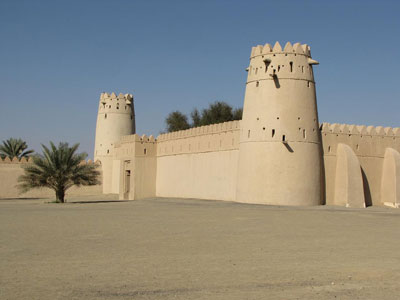 |
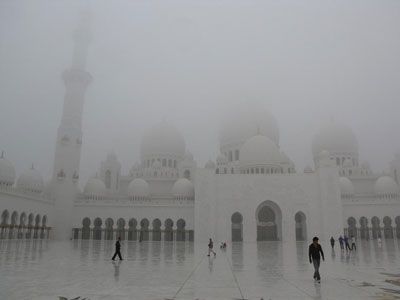 |
The fort in El Ain Oasis, Abu Dhabi |
The Great Mosque in the mist |
Some members of the group took the opportunity to spend a few days in Abu Dhabi before the Sudan program to explore the history and culture of the United Arab Emirates. Ian and I visited the historic oasis of El Ain and saw the ancient forts in the area and the picturesque palm gardens. The local museum had a collection of artefacts covering the early phases of human life in the region. In Abu Dhabi city itself we visited the Grand Mosque, which was shrouded in mist, and the new �Palace Hotel� with its stunning gilded ceilings - the gold dusted coffee and chocolate cake was a must!
We met the rest of the group in Abu Dhabi airport for the onward flight to Khartoum. This was a fascinating flight as we got to see the landscape of the Sudan including the junction of the Atbara River and the Nile, and then the junction of the White and Blue Niles at Khartoum. We had our visas processed at the airport and then made our way to the Grand Holiday Inn which is located on the Nile front. This is a grand old hotel which has recently been renovated, which has a wonderful old world charm. The first afternoon we walked along the Nile and crossed over to Tuti Island, located where the two Niles join on the northern side of the city. The city has a series of new high-rise buildings which tower over the area.
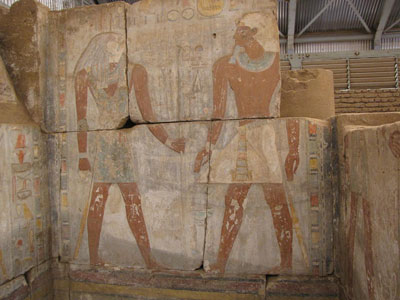 |
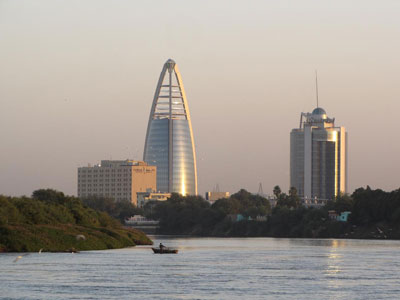 |
The beautiful reliefs of Buhen Temple in Khartoum |
The confluence of Blue and White Niles at Khartoum |
On our first full day in the Sudan, the 11th January, we drove through downtown Khartoum to the Ethnographical Museum - this area of the city is the old colonial quarter with its grand civic buildings of the British era (early 20th Century). The Museum collection included artefacts from the different cultures of the Sudan and Ayad gave us an interesting introduction to the various cultures. We then went to the Archaeological Museum - this includes many beautiful objects and three 18th Dynasty temples (from the sites of Buhen, Semna, and Kumma) which were rescued by UNESCO and moved from the Lake Nasser area following the construction of the Aswan Dam. The Museum collection, well laid out, included a fascinating collection of artefacts from Sudan�s ancient history including Kerma pottery, statues and stela of Egyptian make, and objects from the Nubian pharaohs from the Kingdoms of Napata (8th to 3rd Centuries BC) and Meroe (3rd Century BC to 4th Century AD). We then drove to Omdurman, on the west bank of the Nile, where we had some lunch, and the afternoon was spent with a motor boat trip to the confluence of Blue and White Nile. It was fascinating to see the difference between the churning waters of the still flooded White Nile flowing next to the calmer waters of the more placid Blue Nile.
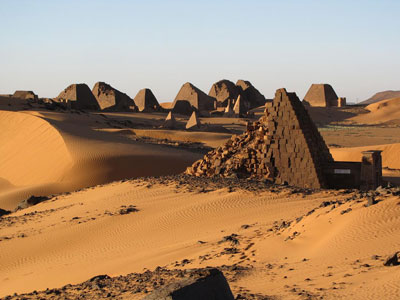 |
 |
Meroe at sunset - magical |
Exploring the pyramid chapels at Meroe |
The following morning we loaded up our 5 four-wheel drives for the journey northward through the desert to the ancient ruins of Meroe. Our route was by asphalt road most of the way although we made a diversion to see the granite boulders of the 6th Cataract. Here the river dips sharply as it falls over a pronounced ledge. In the late afternoon we arrived at Meroe where we caught our first glimpses of the more than 40 pyramids making up the Royal Necropolis. Much smaller than the Giza Pyramids in Egypt, the pyramids at Meroe are solid structures with the burial chamber located underground. Small mortuary temples, many still preserving rich relief decoration, are located on the eastern side of each pyramid. The sweep of the desert sands and the view of the monuments in the afternoon glow of the setting sun will remain with us all forever.
We stayed three nights at the permanent tented camp of Meroe - this gave us a beautiful view of the pyramids at different times of day. The tents were very comfortable and furnished with beds, desks and chairs, and each had its own assigned bathroom - meals were catered by local staff in the nearby restaurant building. If this is camping then it sure is luxury!
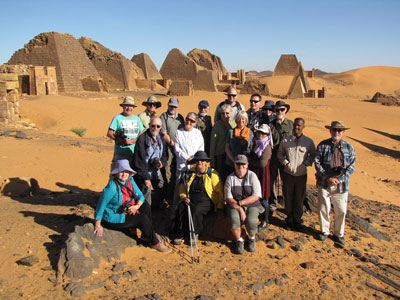 |
 |
The 2011 Sudan group at Meroe |
The Temple of Amun at Naga |
On Thursday 13th January we visited the stunning Necropolis of Meroe definitely one of the highlights of our visit to the Sudan. The cemetery is located about 3km from the Nile on a series of ridges covered with sweeping sand drifts. More than 40 pyramids are located in the North and South Cemeteries, constructed by the �black-pharaohs� of Meroe between 270 BC and 350 AD. The pyramids are 30 to 40 m high and in front of each one there is a small mortuary temple decorated with bas-reliefs that depict the King or Queen associated with the Egyptian funerary Gods like Osiris and Isis. We had great fun exploring these wonderful shrines with their distinctive raised relief decoration. In the afternoon we visited the Royal City of Meroe with its remains of the Temple of Amun, the royal �bath complex� and minor temples. We also visited the non-royal West Cemetery with its minor pyramids belonging to the nobility.
The following day was spent visiting two important archaeological sites. First we went to see the town of Shendy (an old slave market) and visited its colourful market. The site of Naga is located south of Meroe and it is one of the important religious sites which developed during the Meroitic period. Naga is located a beautiful Saharan environment with low bushes, rocks and sand, and we saw many villagers with their animals at the local well. Nearby was the Apedemak Temple (1st century AD), a wonderful building with relief decoration showing the Nubian god with the head of a lion. Other images includes the Meroitic Pharaoh Natakamani. In front of the temple there is a small kiosk or �bark-shrine� with arches and columns in which we could see a combination of the Egyptian, Roman and the Greek styles.
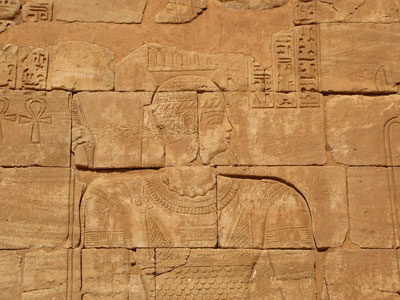 |
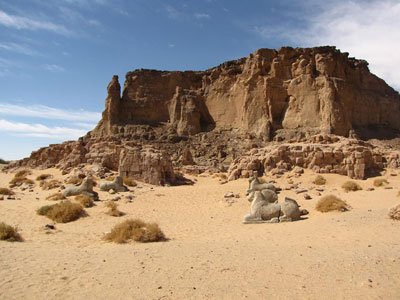 |
King Natakamani at Musawarrat Es-Sufra |
The Temple of Amun at Gebel Barkal |
We had a wonderful lunch in the wild - each day the drivers set up out dining tables and chairs and presented us with a wonderful feast! We then saw the superb Temple dedicated to Amun with its dramatic avenue of rams and a beautiful series of gates and rooms decorated with relief. At the site of Musawwarat, a short distance from Naga, a Meroitic settlement was located in a valley surrounded by hills. We saw the local Temple of the lion god Apedemak, which has recently been restored, and then explored the mysterious Great Enclosure - a number of statues of elephants indicate that this animal had an important role in the area.
On the 15th January we left the Meroe camp and headed north by 4-wheel drive up the road which follows the Nile to the city of Atbara, where we crossed the Nile and headed across the Bayuda Desert. It was a wild dusty morning but the weather cleared as we crossed the vast open plain. We stopped for lunch near an isolated ridge of granite - the local villagers were collecting water at the well and wanted to show us their farm. In the afternoon we saw the ruined monastery of Ghazoli with its very grand church and then stopped to see the impressive sight of Jebel Barkal, an isolated sandstone massive which was sacred to the ancient Nubians. Our accommodation lay on the edge of the town of Karima near the foot of the mountain and was called the Nubian Rest-House. Developed by an Italian company, it consisted of comfortable rooms around a garden courtyard with a central lounge and dining building.
 |
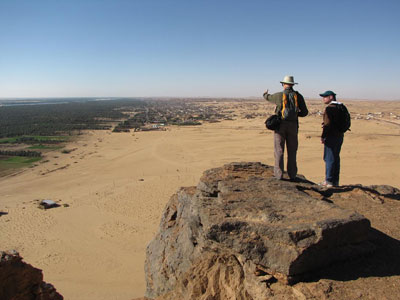 |
The burial chamber of King Tanutamani at El Kurru |
The view from Gebel Barkal |
The following morning was dedicated to the temples at the foot of Jebel Barkal. Here there is a large temple dedicated to Amun, religious heart of Nubia for more than 1,000 years. In front of the ruins of the temple there are several granite rams which formed an avenue that led to the Nile. We also saw other temples in the area including the fascinating Temple of the Goddess Mut which was carved into the mountain side by King Taharka of the 25th Dynasty. It preserves superb reliefs of the king in adoration of the gods, and a scene showing Amun of Jebel Barkal as a ram-headed man inside the mountain. The local Museum contained artefacts from the excavations.
We then visited the Royal Necropolis of Napata, which has pyramids from the 3rd to 1st Centuries BC. After lunch we saw the nearby site of El Kurru where we visited two royal tombs. Belonging to King Tanutamani and his mother Qalhata, the underground chambers were excavated in the bedrock under pyramids, now largely collapsed and robbed away. The walls of the chambers are decorated with superb images of the Pharaoh and the gods and contain ritual hieroglyphic inscriptions. Late in the afternoon we made a visit to an area in the desert which is rich in fossilised tree trunks.
Monday 17th January was set aside to rest and relax but there was very little chance that this would occur! Most of us instead walked over to Jebel Barkal and climbed to the summit for a stunning view of the Nile Valley. The landscape could be seen stretching far away, and we had a chance to have a bird�s eye view of the temples at the foot of the �Holy Mountain�. In the afternoon we arranged to go into Karima to have a look at the local markets and experience something of the local culture. A coffee spiced with ginger was a treat! We also had a look at the old Nile steamers which are now abandoned on the shore.
Our last day in Karima was adventurous and spectacular. It started sedately enough with a visit to the local brick-works where we saw the production of mud bricks in the time-honoured way. From here we went to the Nile shore to board our small motor boat for a cruise up to the 4th Cataract. The river is choked with granite outcrops, which cause the Nile to have reduced navigation (as we discovered!). We enjoyed bird spotting and then stopped and went for a walk on one of the small islands to explore a local village - we enjoyed being invited in to see a village school. We then continued on our journey up river but soon struck a submerged rock and spent about 20 minutes drifting one km downstream until we could be brought by a local fisherman and our captain to a rocky island in the river! Thankfully our captain was able to make repairs to the propeller and we could continue our journey upstream to the rendezvous point. Here we had a picnic lunch in the palm gardens, having experienced the tribulations of ascending the 4th Cataract.
In the afternoon we visited one of the most spectacular sites on our itinerary: the Pyramids of Nuri dated to the Napatan period (7th-4th Centuries). At this site 20 kings and about 55 queens were buried in magnificent pyramids, the most spectacular being that of King Taharka. Nuri has a wonderful remote feeling enhanced by the fact that we were, of course, the only tourists at the site.
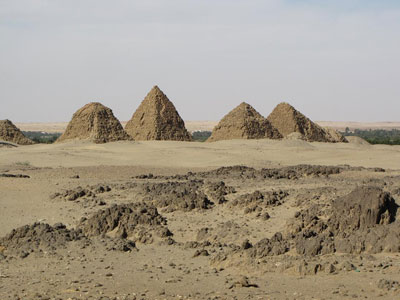 |
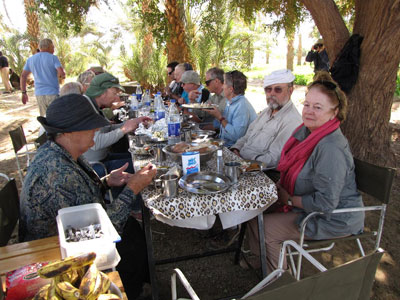 |
The pyramids at Nuri - stunning |
Picnic lunch at Kerma |
On Wednesday 19th January we reluctantly left our wonderful accommodation at Karima and drove through the Nubian Desert towards the north. We then headed to the site of Kerma which was an important cultural centre between 2500-1500 BC. We saw the massive royal tombs where George Reisner found the bodies of hundreds of sacrificed servants and attendants, and after a picnic lunch we explored the fascinating town site with its impressive mudbrick temple known as the �Defuffa�. A visit to the on-site Kerma Museum was a highlight - the recent discovery of a cache of magnificent royal statues has provided unique representations of the Napatan kings including one bearing the ram-horns of the god Amun. In the late afternoon we drove northwards to the area of Tombos where we set up our free camp and watched the sun set over a stunning alien landscape.
The next morning we packed up the camp before visiting the granite quarries of Tombos - here we saw the colossus of a Napatan King (usually said to be Taharqa) and also sae the Tombos stela of Tuthmosis I commemorating his defeat of the Kushites. We then drove north to Sebu, where we saw a collection of rock engravings from prehistoric to Egyptian times. Some showed giraffe, while many represented long-horned cattle. We continued north until we got to the granite boulders of the Third Cataract climbing to a Turkish fort located on the top of a spectacular hill which provides a panoramic view of the landscape.
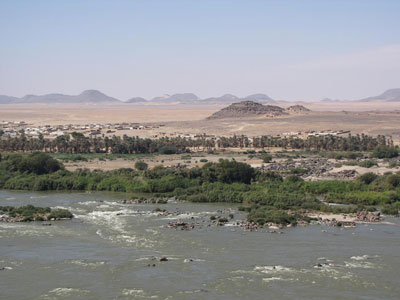 |
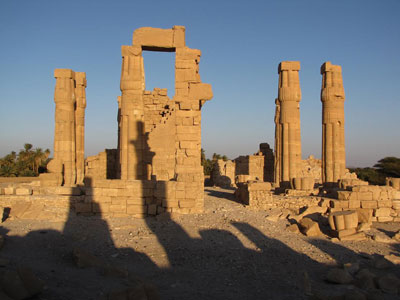 |
The Third Cataract of the Nile |
Soleb Temple at sunset - magical. |
We then crossed the Nile by local car ferry - Shyam did a very good job steering us to the other side. We had some lunch at the ferry stop with a view across the Nile - the local bird life was beautiful with many green �bee-eaters�. We drove northwards through a very desolate landscape dotted with numerous camps where locals are searching for gold and processing the stone. This is the main western road to Egypt and we saw the skeletons of very many camels which had died along the way. In the afternoon we reached the New Kingdom Town of Sesibi which preserves the remains of a temple constructed by Amenhotep III and Akhenaten. We continued on and reached the archaeological site of Soleb at sunset. This superb temple, built by Amenhotep III, is well preserved, and contains numerous relief scenes from the king�s sed-festival. We saw the temple in the afternoon light, and then checked into our accommodation, which took the form of a local house compound with numerous rooms. Later on some of us went back to Soleb Temple in the dark to have a look at the reliefs by torchlight and to watch the full moon rise through the pylon gateways - this was a stunning sight and provided a magnificent eerie glow by which the remains were illuminated.
Early on the morning of the 21st January some of us walked back to Soleb. The early morning light provided a different experience highlighting the richly carved hieroglyphic inscriptions, and we were able to make out the relief figures of Amenhotep IV/Akhenaten on the front Pylon. We drove south again to the ferry stop and recrossed the Nile, having lunch in the local cafe nearby. From here we headed north, eventually arriving at the boat crossing point for the Island of Sai. We took a cruise on the river and all became much excited when we saw enormous Nile crocodiles sunning themselves on the sandbank and then striding into the river and disappearing. When we reached the island shore, the crocodiles were back on the sandbank, seemingly lying in wait for our return.
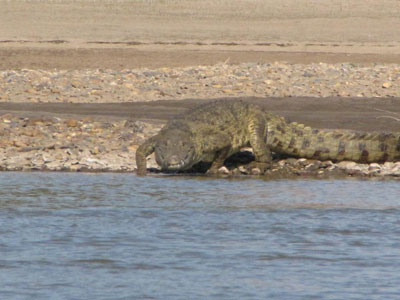 |
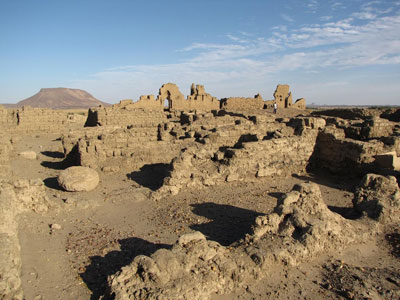 |
A crocodile near the island of Sai |
The Ottoman fort on Sai island |
We spent a few hours looking at the Kerma style tombs on the southern part of the island - these consist of tumuli with black stones lining the outer surface, and white stones filling the centre and top of each mound. There was a lot of lithics and pottery scattered across the desert here. We then went to see the ruins of an Egyptian temple which had been incorporated into the Turkish fort on the island. Late in the afternoon we started southward but troubles with a car engine meant that we had an unscheduled stop in the town of Wawa where we ended up staying in a large family compound for the night.
The next day we continued our journey southward. We stopped for a short visit in the village of Selim where we had a coffee and a walk in the local markets. We then continued south, stopping for a picnic lunch near the Nile and visiting a number of Nubian villages in the area. We were invited into two houses where we met the locals and had a cup of spiced tea. We crossed an area of open sand dunes which came down to the Nile and then reached our camping spot not far from Old Dongola. We were in an area of huge dune drifts and enjoyed a peaceful night under the stars which were something to behold!
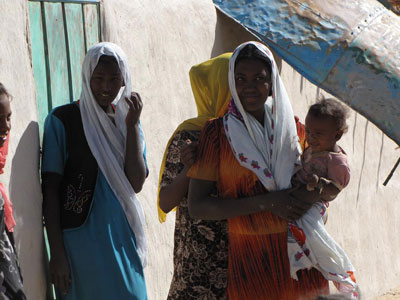 |
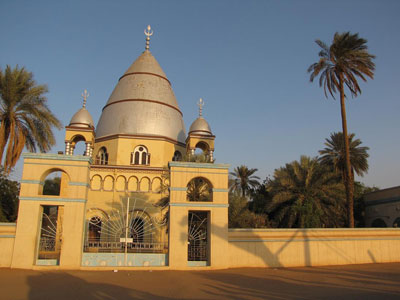 |
Village life near Selim |
The Mausoleum of the Mahdi |
The next day we walked from the camp site to Old Dongola where we explored the Islamic bee-hive tombs and walked over to the ruins of the mediaeval town. Here we saw the outside of the Throne Hall and explored two Christian Coptic churches with marble columns. We then headed south to Khartoum, crossing the Nile via a bridge and then passing through a broad open desert. We arrived in Omdurman, the 19th Century capital of Sudan in the afternoon. We visited the market for tourists (Sudan only get about 2000 tourists a year!) and visited the house of the Khalifa and the mausoleum of the Mahdi. It was very pleasant to get back to our hotel in Khartoum and experience a hot shower after our days of camping.
That evening we went out to a very nice Lebanese style restaurant in Khartoum - the food was excellent and we said out fond farewells to Ahad. The following morning was our last day in the Sudan and some of us went for a walk to explore the book shops and even found a coffee shop. We had had such a wonderful experience of the country - despite the concerns about the referendum and what the situation might be like on the ground, we found the people to be open and friendly, the situation calm, and the antiquities something wonderful.
Michael Birrell
